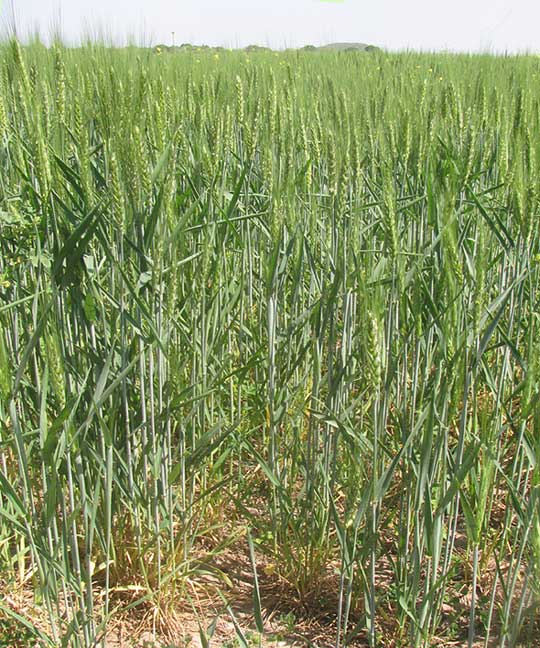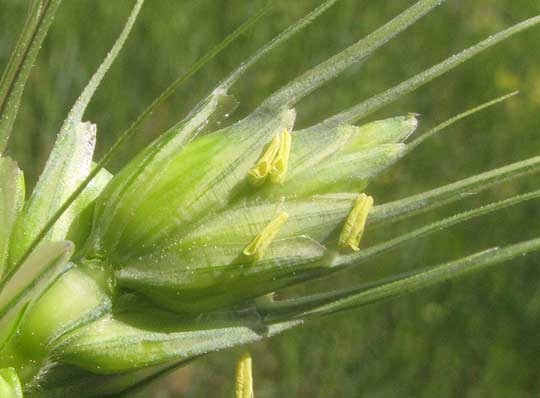Excerpts from Jim Conrad's
Naturalist Newsletter
from the April 6, 2014 Newsletter issued from the Frio Canyon Nature Education Center in the valley of the Dry Frio River in northern Uvalde County, southwestern Texas, on the southern border of the Edwards Plateau; elevation ~1750m (~5750 ft); N29.62°, W99.86°; USA
WHEAT
Wheat fields can be seen here and there around Uvalde. A lush, green field will stand right beside native scrub forest adapted for semi-desert conditions, and the contrast is striking. Below, you can see wheat plants at the edge of a large field:

Common Wheat, which is the third most-produced cereal on earth after corn, or maize, and rice, is TRITICUM AESTIVUM. Several species of the genus Triticum are sometimes grown for food. For example, Durum Wheat, Triticum durum, is the second-most planted wheat species, after Common Wheat, and produces an exceptionally hard, light-colored grain used to make semolina flour for pasta.
Within the Common Wheat species there's enormous variation. In fact, Common Wheat is a concoction of various species; there's no single wild ancestor to Common Wheat. During the last 10,000 years, humans have produced Common Wheat, Triticum aestivum, from a variety of genetic sources. It's enough to point out that, genetically, Common Wheat is an "allohexaploid," which means that it contains six sets of chromosomes, two sets from each of three different ancestral species.
One of the most obvious differences between the different Common Wheat varieties is that some varieties produce heads of spikelets bearing long, needle-like awns, while other varieties are awnless. Holding a head of one of our Uvalde plants up for a look, it was easy to see that the variety in this produced very substantial awns, shown below:

That head consists of 15 or so spikelets, which attach to the stem, or "rachis," alternating with one another, so that the first spikelet from the bottom has above it the third spikelet, while the second spikelet from the bottom is below the fourth spikelet, and so on up the rachis. A close-up of one spikelet containing five or so florets, with yellowish, pollen producing anthers dangling outside, is shown below:

Several hundred wheat varieties are recognized, and they all can be assigned to one of six basic wheat classes. They are: hard red winter; hard red spring; soft red winter; durum; hard white and; soft white. Texas A&M University operates an Agricultural Research and Extension Center at Uvalde, and several studies have been conducted in the area, focusing on varieties that can grow best in our unusually hot environment.
"Spring wheat" and "winter wheat" are not varieties or wheat classes, but rather just wheat that's grown at certain times of the year. Winter wheat, which normally accounts for 70 to 80 percent of U.S. production, is sown in the fall and harvested in the spring or summer; spring wheat is planted in the spring and harvested in late summer or early fall. Therefore, our picture taken in the spring shows "winter wheat."